by boredomresearch (Vicky Isley & Paul Smith), February 2016, Silent Signal Symposium.
We use contemporary technology to explore the natural world, exploring biological mechanisms and form and experimenting with pattern and diversity. We are interested in population dynamics and emergent behaviour. Our work explore processes of change over extended time scales through dynamic behaviour and movement and more recently poetic expression of scientific data.
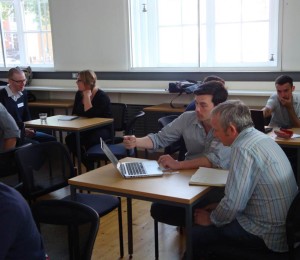
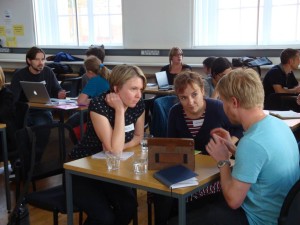
We first met Dr Paddy Brock at Animate Projects’ Silent Signal speed dating session, spending a day in a room of scientists sharing their interest and looking for sparks of romance.
During our speed dating session with Paddy he presented a simulation of disease transmission built using NetLogo (a multi-agent, programmable modelling environment). The simulation presented a black space populated by small graphic representations of humans, changing colour depending on their status, from susceptible, through to exposed, then infected and hopefully ending at recovered. It was fascinating how similar our worlds seemed. Was the difference just our use of terminology?
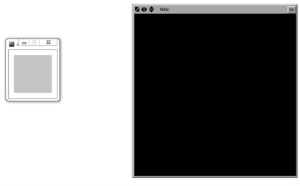
On the right the ‘world’ of NetLogo, and on the left the ‘canvas’ of processing, a language designed for artists. This was something we were keen to explore.
We quickly learnt a lot about what makes mathematical models valuable in a scientific context.
For a start the approachable graphic nature of that first NetLogo simulation was… let’s say misleading. It soon transpired that most of Paddy’s work could better be described as intimidating to an untrained audience. As he gained a, possibly misguided, confidence in our ability to comprehend his code, Paddy sent us more example programs. These used a programming language principally designed for statistical analysis. And we offer our sincerest sympathy and respect to all users of R (image below).
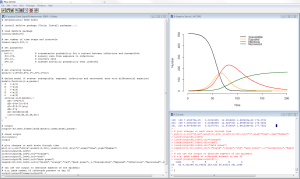
We were keen to understand the differences between an artistic & scientific expression.
Often they would appear quite similar while at the same time quite different. We wondered how could something so abstract and reductive constitute an accurate depiction of reality.
Mathematical models of disease transmission
Models are ways of exploring the dynamics of systems, i.e. the way that things work. For example, we can observe A and C, but we know that A influences C only through B. We could create several models/hypotheses of how A->B->C and compare the outputs of these simulated systems to the real world, i.e. what we observe. All models are abstractions to some degree. All models are wrong, but some are useful.
Here we see a simple model of four states that individuals in a population can take through time as an infection arrives and spreads through a population. The system of flow of individuals through compartments, with the structure of the compartments is the hypothesis, and we can estimate the rate of flow between them using the data. We could do this for say Ebola or Zika (which would have different model structures), and then use our model of transmission to test how best to reduce infection using different interventions.
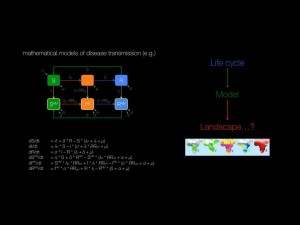
This is a similar model, this time looking at co-infection between HPV (Human papillomavirus) and HIV – here you can see the compartments, and the set of differential equations that determine the change in the number of individuals in each compartment per time step. Simulation models like this produce all sorts of weird and wonderful outputs. However, when used as tools in science, the focus is on results, and opportunities to explore for exploration’s sake get passed by. boredomresearch’s work appealed to Paddy as a great way to do this sort of exploration. Paddy feels our work is similar (superficially in some ways, truly in others) to the mathematical modelling of disease transmission; it uses similar tools, but the incentives and insights are quite different.
Another point of common interest that emerged through our collaboration was landscape, which boredomresearch explore creatively and aesthetically, and which links to a hot topic in research epidemiology, which is the question of how transmission models can be related to spatial variation. Paddy may simplify the life cycle of an infectious agent into a mathematical model, but how best to link this back to natural variation in space is a tricky and much discussed issue.
This is especially the case for malaria – despite lots of progress in the last 15 years, more than half a million people are still killed by malaria every year – most of them children in sub-Saharan Africa. What Paddy’s research aims to do is develop understanding of how transmission occurs in space in a way that can be used by control programs to most effectively reduce transmission‚ this is an especially complicated issue in the system on which he is currently working, where malaria circulates in macaques in South East Asia, particularly in Malaysian Borneo, and spills over in humans via mosquitoes…
Plasmodium knowlesi
The project that Paddy is working on now is inherently spatial, and has really lent itself to our collaboration.
Plasmodium knowlesi: As described in 2004, it is a zoonotic malaria and now a leading cause of malaria in Malaysia. A large consortium project was set up to define what determines the risk of human infection with it.
Spillover infection risk: The modelling component of the project aims to bring together data from primatology, social science, clinical work, entomology etc. to understand what drives transmission.
The important questions are whether there is human vector human transmission (and how/when/where this occurs), and how the dynamics are influenced by land use change.
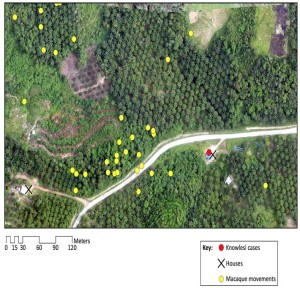
Drone images are used to collect fine-scale data on habitat, land use and fragmentation.
The collars on some macaque troops are used to get an idea of the way they move, and in what kind of locations they roost, feed and travel through. But it is difficult to get decent data on macaques as we know little about them.
It also meant that we had a space – a piece of landscape to focus our discussion on – so we’ve been working with the island of Banggi, just off the northernmost tip of Malaysian Borneo, one of Paddy’s intensive study sites. However there were still lots of unknowns, especially with relation to the monkeys.
AfterGlow
Ultimately the project developed into a real-time simulation of an infection transmission scenario called AfterGlow – but one built with a primarily artistic motivation.
In AfterGlow we use a 3D game engine to explore an infection scenario from a landscape perspective. The landscape is locked in perpetual twilight, which is prime blood feeding time for mosquitoes.
We were not interested in providing results and data but instead an experience of the immense complexity of a zoonotic infection, which is one that can be transmitted to humans from animals. This particular infection scenario is inspired by Paddy’s work with Plasmodim knowlesi and the island of Banggi.
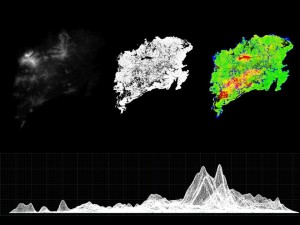
On the left is the height info from Banggi Island where Paddy is doing his research. We used this to create the fictional landscape in which our scenario would take place, adjusting the height scale to make the features more visible.
We also have maps of forest cover, food and water source. We then created a model of macaque behaviour where we have groups of macaques that wonder the island in search of food.
You don’t see the macaques.This is not too far from reality where they can often be quite illusive – no one knows how many troops are on the island. This is just one many fascinating holes in the scientific data.
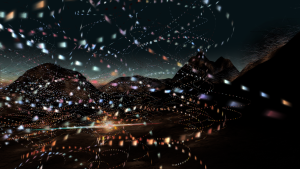
In AfterGlow, you do see the mosquitoes that become infected when they bite a macaque. Macaques are the natural host – with a high number testing positive for Plasmodim knowlesi. Mosquitoes that become infected with Plasmodim knowlesi are expressed as spiralling forms evocative of mosquito flight paths. These forms are made of cells of colour which we think of as the packets of infected blood being transmitted around the landscape
An autonomous camera wonders the landscape moving in and out of pockets of infection. Often the camera will pass through pockets of infection that are so dense that the landscape is obliterated in a blizzard of infection. However most of this material is benign. It has to develop in the growth cycle of the mosquito before it becomes infectious.
We were interested in latency – mosquitoes don’t live very long on average, but the parasite needs a minimum period to develop inside them and to bite at least one infectious host and at least one susceptible host at the right times to transmit. In other words, biologically it seems that the odds are stacked against malaria transmission, something we found very interesting.
In AfterGlow the spiral forms also have a latency period. If they persist for long enough they erupt into turbulent dark forms.
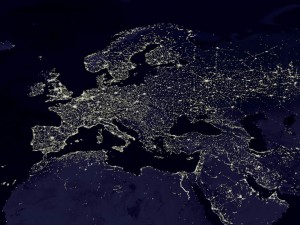
One of our original inspirations was night-time satellite imagery revealing the shape of human habitation.
We wondered what shape the infection might take and how it would interact with the landscape?
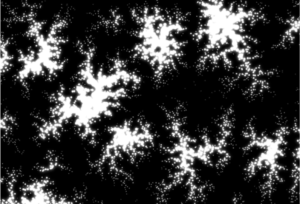
In AfterGlow as the camera wanders the landscape it occasionally passes over a high summit where we are presented with a natural overview or map revealing the shape of the infection.
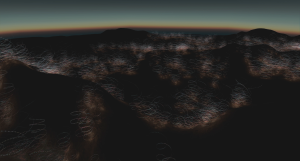
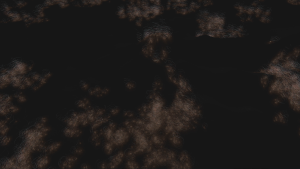
The view presented in AfterGlow can change smoothly from the overviews more common in science to a first person perspective of landscape. This first person perspective provides a strong sense of the spatial qualities and complexities of this type of infection scenario.
This was an element, which Paddy was interested in – the value of spatial sensitive representations for the future of epidemiology, emergent properties of the landscape, nonlinearities of the system, and creative element of the scientific process that is often unacknowledged.
Thank you to Animate Projects, NCCA, Bournemouth University and Wellcome Trust.
boredomresearch is a collaboration between Vicky Isley and Paul Smith, British artists and research lecturers in Computer Animation. Fascinated by the mechanics of the natural world, they use computational technology to simulate natural patterns, behaviours and intricate forms that gradually change over time.
boredomresearch’s work opens channels for meaningful dialogue and engagement between public and scientific domains. Their artwork Real Snail Mail was the world’s first webmail service to use real snails, challenging our cultural obsession with speed and received worldwide attention.
Based at the National Centre for Computer Animation, Bournemouth University, their work benefits from a fine blend of art and science – allowing them to achieve projects underpinned by a deep appreciation of the creative possibilities of technology.

